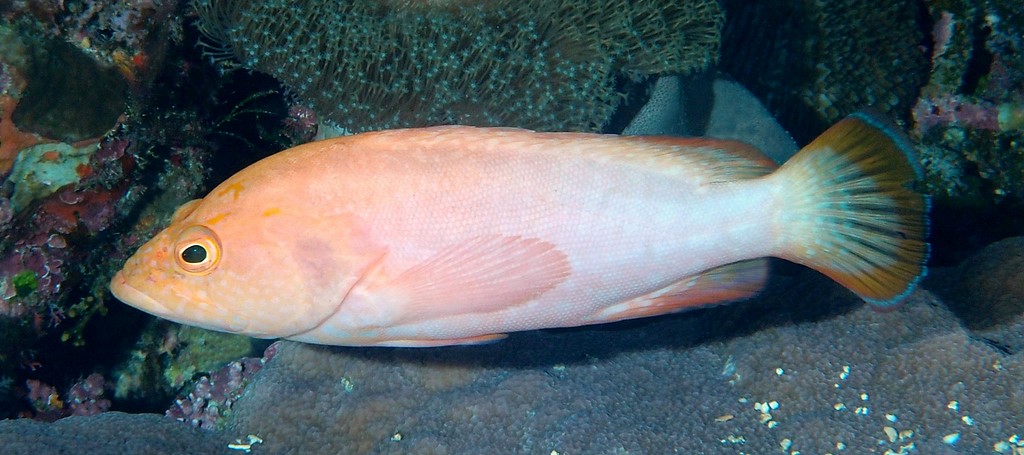CEPHALOPHOLIS SPILOPARAEA - (VALENCIENNES, 1828)
Actinopterygii (Gigaclass) > Actinopteri (Class) > Teleostei (Subclass) > Perciformes (Order) > Percoidei (Suborder) > Epinephelidae (Family) > Cephalopholis (Genus)
Merou fraise, Vielle fraise, Orange rock-cod, Orange-red pigmy grouper, Strawberry cod, Strawberry grouper, Strawberry rockcod, Strawberry grouper, Strawberry hind, Aarbei-klipkabeljou, Erdbeer-Zackenbarsch, Jordbærbars, Akahana, Garoupa marinheira, Cherna frutillera, Akahana, アカハナ, 暗金九刺鮨, 黑边九棘鲈,
Synonymes
Cephalopholis spiloparae (Valenciennes, 1828)
Serranus spiloparaeus (Valenciennes, 1828)
------------------------
Description
Dorsal spines (total): 9; Dorsal soft rays (total): 14-16 (usually: 15); Anal spines: 3; Anal soft rays: 9-10; Pectoral fin rays: 17-19; Lateral line scales: 47-52. Longitudinal scale series: 87-100; Pelvic fins short, not reaching annus: 1.9-2.15 in Head Length; Greatest depth of body: 2.75-3.2 in SL. Body scales ctenoid, cycloid scales ventroanteriorly on abdomen; Rounded caudal fin; Eyes large, diameter about twice the depth of the preorbital; Interorbital area flat; Rounded preopercle, very finely serrate, shallow notch, fleshy lower edge; Smooth or with serrae subopercle and interopercle; Scaly maxilla, reaching to or well beyond vertical at rear edge of eye. Max. length: 30.0 cm TL. Depth range: 15 - 108 m, usually: 30 - 108 m.
Color
Pinkish red to pale reddish orange color; Mottling of darker red to brownish red; Median fins with narrow blue marginal stripe.
Etymology
Cephalopholis: from Greek, kephale = head + from Greek, pholis = scale. Referring to completely scaled head of Cephalopholis argus.
spiloparaea: from ancient Greek, spilos = spot + from Latin, pareius = cheeked. Described as having “numerous and well marked” brown spots on cheeks “but barely visible on body”.
Original description: Serranus spiloparaeus Valenciennes, 1828 - Type locality: no locality stated, Indian Ocean.
Distribution
Indo-West Pacific: East Africa, Comoros, Madagascar and western Mascarenes east to Pitcairn Group, north to Taiwan, Ogasawara and Wake islands, south to Western Australia, Queensland (Australia), New Caledonia and Rapa.
Biology
Found in coral reefs. Feeds on crabs and other crustaceans. Solitary. The small size (<22.0 cm TL) and deep-water habitat of this species makes it less vulnerable to fishing.
Similar species
Cephalopholis aurantia (Valenciennes, 1828) - Reported from New Caledonia.
Cephalopholis leopardus (Lacepède, 1801) - Reported from New Caledonia. A dark black saddle spot on caudal peduncle, followed by a smaller spot. An oblique dark brown or reddish streak on upper part of caudal fin submarginally.
Last update: 14, June 2022
Merou fraise, Vielle fraise, Orange rock-cod, Orange-red pigmy grouper, Strawberry cod, Strawberry grouper, Strawberry rockcod, Strawberry grouper, Strawberry hind, Aarbei-klipkabeljou, Erdbeer-Zackenbarsch, Jordbærbars, Akahana, Garoupa marinheira, Cherna frutillera, Akahana, アカハナ, 暗金九刺鮨, 黑边九棘鲈,
Synonymes
Cephalopholis spiloparae (Valenciennes, 1828)
Serranus spiloparaeus (Valenciennes, 1828)
------------------------
Description
Dorsal spines (total): 9; Dorsal soft rays (total): 14-16 (usually: 15); Anal spines: 3; Anal soft rays: 9-10; Pectoral fin rays: 17-19; Lateral line scales: 47-52. Longitudinal scale series: 87-100; Pelvic fins short, not reaching annus: 1.9-2.15 in Head Length; Greatest depth of body: 2.75-3.2 in SL. Body scales ctenoid, cycloid scales ventroanteriorly on abdomen; Rounded caudal fin; Eyes large, diameter about twice the depth of the preorbital; Interorbital area flat; Rounded preopercle, very finely serrate, shallow notch, fleshy lower edge; Smooth or with serrae subopercle and interopercle; Scaly maxilla, reaching to or well beyond vertical at rear edge of eye. Max. length: 30.0 cm TL. Depth range: 15 - 108 m, usually: 30 - 108 m.
Color
Pinkish red to pale reddish orange color; Mottling of darker red to brownish red; Median fins with narrow blue marginal stripe.
Etymology
Cephalopholis: from Greek, kephale = head + from Greek, pholis = scale. Referring to completely scaled head of Cephalopholis argus.
spiloparaea: from ancient Greek, spilos = spot + from Latin, pareius = cheeked. Described as having “numerous and well marked” brown spots on cheeks “but barely visible on body”.
Original description: Serranus spiloparaeus Valenciennes, 1828 - Type locality: no locality stated, Indian Ocean.
Distribution
Indo-West Pacific: East Africa, Comoros, Madagascar and western Mascarenes east to Pitcairn Group, north to Taiwan, Ogasawara and Wake islands, south to Western Australia, Queensland (Australia), New Caledonia and Rapa.
Biology
Found in coral reefs. Feeds on crabs and other crustaceans. Solitary. The small size (<22.0 cm TL) and deep-water habitat of this species makes it less vulnerable to fishing.
Similar species
Cephalopholis aurantia (Valenciennes, 1828) - Reported from New Caledonia.
Cephalopholis leopardus (Lacepède, 1801) - Reported from New Caledonia. A dark black saddle spot on caudal peduncle, followed by a smaller spot. An oblique dark brown or reddish streak on upper part of caudal fin submarginally.
Last update: 14, June 2022
